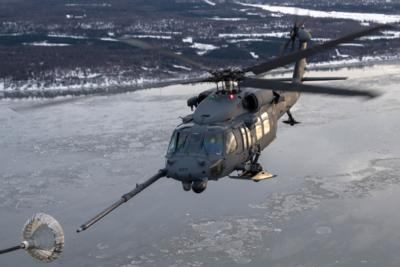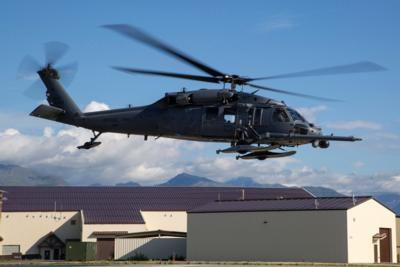Part Of A North American Aerospace Defense Command Arctic Air-Defense Operation
Alaska Air National Guardsmen from the 176th Wing participated in operation Noble Defender, a search and rescue/personnel recovery (SAR/PR) exercise Jan. 19-22. Noble Defender is a North American Aerospace Defense Command Arctic air-defense operation conducted in south-central Alaska.

“The Noble Defender series seeks to support a variety of campaign objectives for NORAD Command,” said Col. Joseph Alkire III, 611th Air Operations Center deputy commander. “While the Noble Defender series can exercise a wide range of activities, objectives center around the demonstration and ability to conduct agile combat employment principles across North America.”
Alkire said the latest iteration is tailor-made for demanding Alaska winter conditions.
“The most recent Noble Defender event in January 2021 emphasized homeland-defense missions and initiatives in the Arctic, specifically exercising personnel recovery, greater search and rescue operations as well as the ability to conduct combat search and rescue in an adverse Arctic operating environment,” he said.
Included in the 176th Wing’s participating units were combat rescue officers pararescue Airmen, or PJs, and survival, evasion, resistance and escape specialists from the 212th Rescue Squadron, HH-60G Pave Hawk aircrew from the 210th Rescue Squadron and HC-130J Combat King II aircrew from the 211th Rescue Squadron.
The Airmen from the three squadrons compose the wing’s “rescue triad,” CROs, PJs, and SERE – known collectively as Guardian Angels – are experts in SAR/PR operations and are trained to infiltrate behind enemy lines to extract isolated U.S. and allied personnel. The HH-60G aircrew is trained to use the helicopter’s sensor suite to find isolated personnel, and they are capable of infiltrating Guardian Angels by landing or using the aircraft’s rescue hoist. The HC-130J personnel are trained to use the propeller-driven aircraft’s sensor suite to find isolated personnel at higher altitude and greater speed than the HH-60 and can infiltrate Guardian Angels by low or high-altitude parachute drops. Normally, the HH-60 is the primary means of extraction since the all-weather helicopter can land just about anywhere, and the crew can employ the rescue hoist when they can’t land. In order to extend the range of the HH-60G, the HC-130 deploys booms from pods
underneath either wing to refuel the HH-60G in flight.

Providing command-and-control for the rescue triad is the Alaska Rescue Coordination Center, which is also staffed by Alaska Air National Guardsmen who are detailed full time to the regular Air Force’s 11th Air Force. The AKRCC at Joint Base Elmendorf-Richardson is outfitted with an advanced communications suite, and the SAR controllers regularly coordinate with the Alaska State Troopers, Civil Air Patrol, national and state park services, and local-community authorities.
Alkire highlighted the importance of SAR/PR to the total force.
“The Air Force places special emphasis in the recovery of its Airmen and specifically organizes trains and equips for the spectrum of personnel recovery operations,” he said. “Although Airmen may place natural emphasis on the recovery of fellow Airmen, Air Force philosophy is based on the assumption that rescue forces are prepared to recover its isolated personnel any time and any place. Rescue is a key element in sustaining the morale, cohesion and fighting capability of friendly forces,” Alkire continued. “It preserves critical combat resources and influences the course of national and international politics by denying adversaries the opportunity to exploit the intelligence and propaganda value of captured personnel.”
Alkire said the exercise was just one wavelength in a wide spectrum of SAR/PR missions the 176th Wing and AKRCC execute.
“While rescue can offer challenges far and wide, the ability to operate and succeed given the tyranny of distance and the harsh Arctic operating environment forever complicate any rescue which is why it is so very important to exercise and reinforce rescue skill sets and capability within the Alaska Region in its support to homeland defense,” he said. “These Air National Guard units, with concurrent rescue responsibility to the state of Alaska, NORAD and U.S. Northern Command homeland defense, and to other tasked combatant commands like U.S. Central Command and U.S. Africa Command keep the units on a robust operations tempo not often seen in most units.”
Alaska Air National Guard Maj. Daniel Kozak, 211th RQS HC-130 pilot and aircraft commander, summarized the wing’s mission profile during the exercise.
“The point of this flight today is to practice our search-and-rescue capabilities,” he said. “Every time a mission drops from the RCC, we are deployed to search for the survivor. Our triad, the HH-60’s, HC-130J’s, and 212th Rescue Squadron, work together to locate and extract civilians and military personnel during peace and wartime missions respectively.”
Kozak said the SERE specialist simulating the downed pilot used a satellite beacon to provide the HC-130 with his location, and he communicated with the crew using a UHF/VHF radio.
“To accomplish this mission, we practice scenarios locating simulated survivors using the HC-130’s electro-optical infrared camera and radios,” Kozak said. “Forward-looking infrared and radios are used on the HH-60. A care package is sometimes airdropped via the HC-130 and can include radios so the pilots and survivors can communicate with us.”
Once the crew located the simulated pilot, the HC-130J loadmaster airdropped a package tailored for the Arctic with survival gear the isolated person could use to stay safe and healthy until the HH-60 arrived to pick him up.
Additionally, Guardian Angels are especially suited for operations in the Arctic with special cold-weather equipment added to their continual training in mountainous terrain under challenging weather conditions. The rescue triad, in partnership with the AKRCC, keep their skills sharp by providing statewide civil SAR support, rescuing isolated hikers and injured hunters throughout the course of the year.
“The incredible skill array of the HH-60G Pave Hawk helicopter, the HC-130J Combat King II fixed wing aircraft, and the Guardian Angel pararescue-jumpers offer an incredible technical rescue capability across the spectrum of peace and wartime operations not seen anywhere else in the world,” Alkire said. “The ability of these units to operate and survive in the Arctic is unparalleled and critical to the safety and security of not only Air Force personnel operating in the Arctic, but to joint and coalition personnel. The combined capability offered by all rescue forces in the Arctic to include Coast Guard and other civilian agencies offer a rescue umbrella to rapidly respond to a significant geographic region in the fiercest of operating environment across the region.”
 Aero-News: Quote of the Day (11.17.25)
Aero-News: Quote of the Day (11.17.25) ANN's Daily Aero-Term (11.17.25): NonDirectional Beacon
ANN's Daily Aero-Term (11.17.25): NonDirectional Beacon NTSB Final Report: Fred L Wellman CH 750 Cruzer
NTSB Final Report: Fred L Wellman CH 750 Cruzer ANN's Daily Aero-Linx (11.17.25)
ANN's Daily Aero-Linx (11.17.25) Airborne-NextGen 11.11.25: Archer Buys Hawthorne, Joby Conforms, Stranded Astros
Airborne-NextGen 11.11.25: Archer Buys Hawthorne, Joby Conforms, Stranded Astros




